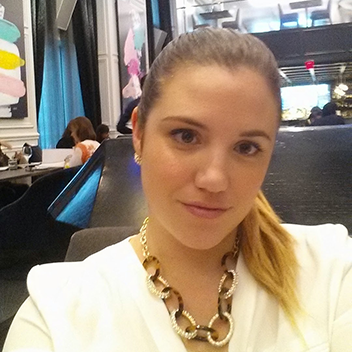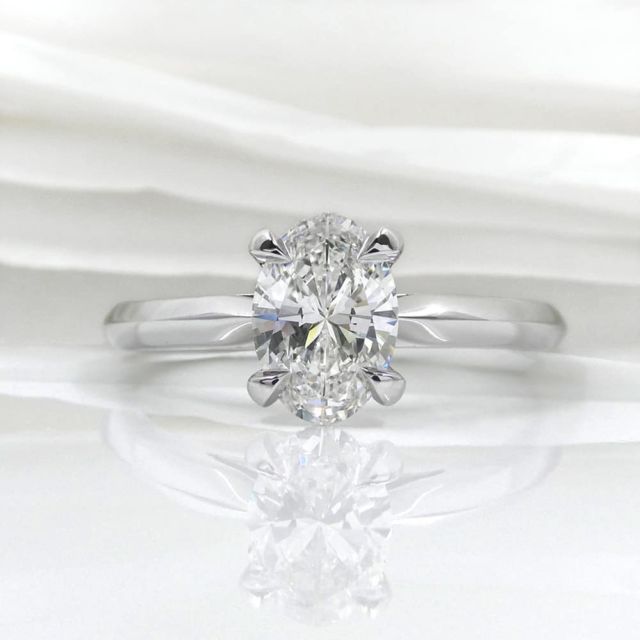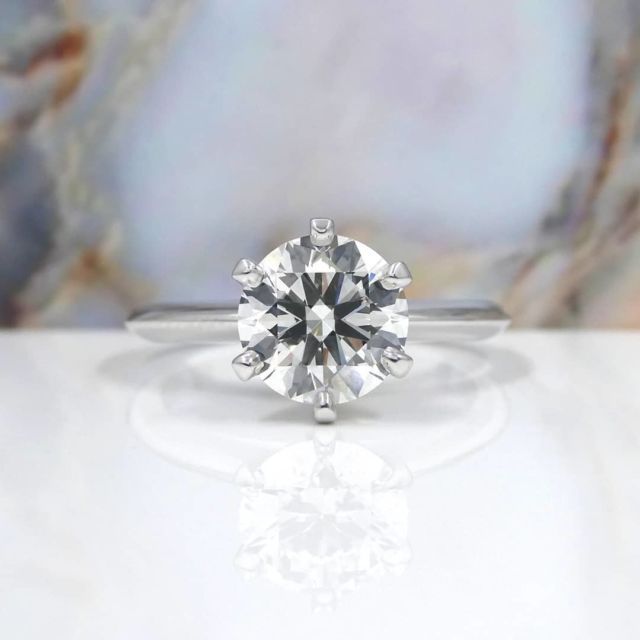Sara Cumming is the Jewelry Production and Social Media Coordinator at Kimberfire – a brilliant way to buy diamond engagement rings, fine diamond jewelry, and loose diamonds in Toronto, ON and across Canada. She holds a Bachelor of Fine Art from York University and a Diploma in Jewelry Arts from George Brown College. She is skilled in jewelry design using CAD software, as well as traditional goldsmith techniques. When she is not immersing herself in all things jewelry, Sara is a dog mom to Barley, her beagle mix rescue dog who loves a good tummy rub.
Birthstones: Sapphires, Diamonds and Rubies, Oh My!

It’s the month of April and winter has finally ended. The grass is growing, the sun is shining and April babies are celebrating their birthdays. And just what kind of gift should you get for an April birthday? A diamond of course! The diamond is April’s birthstone as well as being one of the most popular and desired gems throughout history. But where did the tradition of birthstones come from? Let’s take a look.
Ancient Beginnings of the Birthstone
Since the beginning of human history, people have been drawn to the beauty and mystery of gemstones. Ancient cultures believed that certain gems had special powers and healing qualities. There is evidence of Ancient Indian and Tibetan cultures wearing birthstones, although they were used in mythical or medicinal ways. A lot of scholars believe the origin of birthstones originated from a story in the Old Testament about the breastplate of Aaron. Aaron was the High Priest of Israel and brother of Moses and he wore a breastplate covered in 12 different jewels representing the 12 tribes of Israel. Titus Flavius Josephus wrote in the 1st century AD of the connection between the 12 stones of the Jewish breastplate and the 12 signs of the Zodiac, where each Zodiac sign had its own gemstone. In Astrology each gemstone was connected to a specific sign and when the sun was in that sign, that gem would hold special talismanic powers.
Birth of the Modern Day Birthstone
In 1752 the Gregorian calendar divided the year into 12 months. Soon after this time the idea of a specific stone being connected to a specific month began. The modern tradition of wearing birthstones has been traced to 18th century Poland, when Jewish gem traders moved to the region. Initially people wore the stone of the current month and rotated each month through the 12 stones. Eventually this changed to people only wearing the stone of their birth month.
The Birthstone We Know and Love
Throughout Europe birthstones had become popular and in 1870 Tiffany and Co. published a pamphlet all about birthstones. In 1912 an official birthstone list was created by the American Association of Jewelers. On this standardized list some months had multiple birthstones to add more affordable and available options. In 1952 the list was updated and more options were added or replaced. The most recent change was in 2002 when the gem tanzanite was added as an option as the December birthstone.
A New Month, A Different Stone (or Three!)
January Garnet
Garnets are actually a set of closely related minerals that form a group. The traditional colour associated with garnet is a deep red but it comes in almost every colour, and the green garnet called tsavorite is very rare and valuable. The word garnet is derived from the Latin word ‘granatum’ meaning seed, which was in reference to the pomegranate seeds of which it resembled. It has been used as a talisman for travellers as it was believed to protect and ensure safe journeys.
February Amethyst
The amethyst is a member of the quartz family and is a popular stone because of its wide range of purple colours. The Amethyst was associated with Greek mythology and the God of intoxication, Dionysius. Its name comes from the Greek word ‘Amethystos’ which means sober, as the ancients believed that the gem would protect the wearer from the effects of wine and drunkenness. The amethyst was said to assist in remembering and understanding dreams.
March Aquamarine and Bloodstone
Aquamarine is a variety of the mineral beryl and comes in a light blue-green colour. Its colour is where it gets its name, which means seawater in Latin. Its association with the sea made it a good luck charm for sailors who had it carved into the Roman Sea God Neptune. Aquamarine is also a symbol of happiness and youth. The stone gets its blue colour from iron and the more intense the blue the more valuable the stone.
The traditional birthstone for March was the bloodstone. The bloodstone is dark green jasper with flecks of red spots, which are deposits of iron oxide. It is named for a legend that said the red flecks came from Christ’s blood, which fell to the ground during crucifixion and solidified.
April Diamond
April’s birthstone is the diamond. Diamonds are priced for their 4 c’s, colour, clarity, carat, and cut. The closer to colourless a diamond is, the more valuable it is. The exception to this is when we are talking about fancy coloured diamonds, such as yellow, pink, green, blue and red. These fancy diamonds are very rare and therefore cost more. A diamond consists of only one element, carbon, which is formed deep in the earth under intense pressure and high temperatures. Most diamonds are over a billion years old. Diamonds traditionally stood for strength courage and invincibility as they are the hardest and most durable gemstone. In fact they are 58 times harder than anything else in nature. The name itself comes from the Greek word ‘adamas’ which means invincible. Ancient Hindus believed diamonds were the result of lightening striking rock, Ancient Greeks believed they were the tears of God and Romans believed they gave courage in battle. In modern times the diamond stands for everlasting love and is a symbol of engagements and marriage.
May Emerald
The emerald is a variety of Beryl and is prized for its vivid green colour which comes from chromium or vanadium. Most emeralds have little cracks, flaws, or veins in them called inclusions. These inclusions are routinely treated with oil, wax, or epoxy substances to hide cracks and improve transparency. This is an acceptable trade practise as long as it is disclosed. The emerald represents spring, fertility and rebirth. In the past it was believed to help with clarity of vision, and worn to relieve the pain of childbirth. Emeralds were first mined in Egypt and were said to be Cleopatra’s favorite gem.
June Pearl, Alexandrite and Moonstone
The pearl is the traditional birthstone for June and the only organic birthstone. A pearl is created when a microscopic particle, like a grain of sand, enters between the two shells of a mollusk. To protect itself the mollusk covers this irritant with layers of nacre, which we know as mother of pearl, until the pearl is formed. Cultured pearls are the result of someone deliberately inserting a bead into the mollusk to create the pearl. Pearls are most commonly white but can also be in various colours such as pink, peach, silver, purple, and black. The colours vary because of the types of mollusks as well as the type of water they come from. The pearl is a symbol of purity, which connects it to June, as June was the traditional month for weddings. Pearls are still commonly worn as wedding jewellery today. The ancient Greeks believed pearls were formed when tears of joy fell from the Goddess Aphrodite’s eyes and hardened.
Another birthstone option for June is Alexandrite, which is a colour-change variety of chrysoberyl. Alexandrite is a special gem because it changes colour. It is a blue-green in daylight and a red-purple in incandescent light. It is very rare and very expensive. Alexandrite was discovered in Russia in 1830 during the reign of Tsar Alexander II, and was named after him.
June also has a third option which is the moonstone. Moonstone is a variety of feldspar and has a moon effect of a blue white sheen which is called adularescence. Both Ancient Greeks and Romans associated it with Lunar Gods and Goddesses. Pliny, the Roman historian, said the stone changed colour with the phases of the moon, which is how it got its name.
July Ruby
Rubies are prized for their bright red colour and are one of the most expensive coloured stones. They are a type of corundum, which is second only to diamond in hardness. Rubies get their colour from chromium and the most desirable rubies are called ‘pigeon blood’. They are a symbol of royalty and in England are used for coronation rings. Ancient Hindus called it ‘the king of gems’ and believed if you gave a ruby to the God Krishna you would be reborn as an Emperor.
August Peridot
The peridot is a type of olivine that is prized for its bright yellow green colour. The Egyptians associated the gem with light, and called it the ‘gem of the sun’. It has been mined for over 3500 years; the oldest source is in Egypt. Peridot is often found in volcanic rock and has even been found in meteorites that have fallen to earth. The peridot has been associated with healing, and is said to end night terrors when it is set into gold and worn on the body.
September Sapphire
The sapphire is commonly recognized for its deep blue colour, but in fact sapphires come in almost every colour. The name sapphire applies to any colour of corundum, except red, which is a ruby. Sapphire rings were worn by Catholic Bishops and Cardinals because the blue colour symbolized heaven. Traditionally the sapphire was associated with truthfulness, sincerity and faithfulness. One of the most famous engagement rings in the world was a blue sapphire surrounded by diamonds, which belonged to Princess Diana.
October Opal and Tourmaline
The opal is a unique gemstone which is made of microscopic stacked silica spheres. These spheres show a ‘play of colour’, which are flashes of different colours in one stone. Opals can have a light or a dark background, and the brighter and more distinctive the different colours, the better quality the opal. Ancient people believed the opal brought good fortune because they possessed all the colours and powers of every gemstone. A belief that opals bring bad luck stems from of a novel titled ‘Anne of Gerstein’ written by Sir Walter Scott in 1829. In the book a main character wore an opal and when holy water was sprinkled on it she died. Because of this book, within a year of its release the opal market had crashed and prices were down 50%. Queen Victoria helped opals regain popularity by frequently wearing and gifting opal jewellery.
The second birthstone for October is tourmaline. This gem comes in a huge array of colours and can also be bi- or tri-coloured. In fact the stone’s name comes from the Sinhalese word ‘toramalli’ which means mixed-gems. It also has the unique quality of being charged with static electricity when warmed or rubbed.
November Topaz and Citrine
Generally Topaz is regarded as being a golden brown or blue colour, but it comes in a wide range of colours. Blue topaz is actually a colourless topaz that has been irradiated with electrons to turn it a sky blue colour. The name topaz comes from the Sanskrit word for fire. The golden gemstone was a symbol of the Egyptian sun god Ra, and a sacred stone of the Roman god Jupiter.
An alternative birthstone for November is the yellow type of quartz called citrine. It is named after the French word for lemon. Natural citrine is very rare and almost all citrine was amethyst which had been heat treated to turn it yellow. This gem is believed to bring good fortune and success.
December Turquoise, Zircon and Tanzanite
Turquoise is a vivid blue stone with an opaque, slightly waxy appearance. The ancient Egyptians have been mining it since 6000 BC and they called it ‘mefkat’ which meant joy and delight. The stone is highly prized by both Native American and Persian cultures. The name turquoise means ‘Turkish stone’ as the stone first came to Europe by Turkish sources.
Zircon is another birthstone for December and comes in many colours, but is best known for its blue stones. It has so much fire and brilliance that colourless zircon was often mistaken for diamonds in the past. The zircon is often confused with cubic-zirconia which is a synthetic man-made gem.
Tanzanite is the third option for December and is the newest addition to the birthstone list. It is a blue-purple stone that has become very popular for jewellery. The tanzanite was only discovered in 1967, in Tanzania, which is where it got its name.
What Does a Birthstone Mean to You?
The history of birthstones reveals how humans have always had a close relationship with gemstones. While we all know gems are used for adornment, it is interesting to see how in the past they were used as medicine, therapy, protection and worship. The meanings behind these gems bring another dimension to each stone, rather than being just another pretty colour. As an August baby myself, learning about the Ancient Egyptians’ love of the peridot made me appreciate the stone more. And if after everything you just aren’t a fan of your birthstone, well you can just pretend to be an April baby and get yourself a diamond!
About Kimberfire
A brilliant way to buy high-quality custom engagement rings, diamonds, and jewelry. Discover expert guidance, complete transparency, and unmatched value in Toronto and across Canada.
Share this entry
Leave a Reply
Want to join the discussion?
Feel free to contribute!







